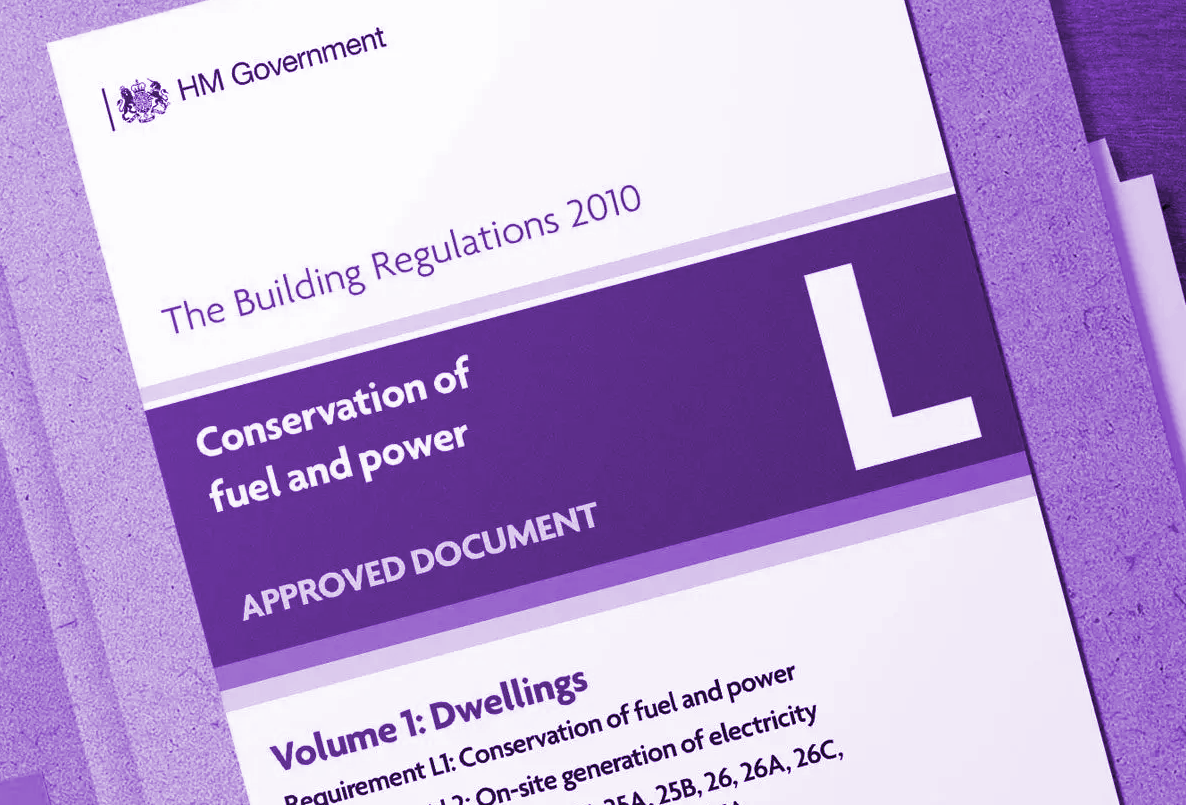
The Benefits of Exceeding Part L Regulations
When it comes to constructing or renovating properties, the minimum standard required by UK Building Regulations, particularly Part L, ensures a certain level of energy efficiency and insulation. While these regulations set a baseline for sustainability and energy conservation, they are far from the ultimate goal. It’s puzzling why homeowners and small developers, aiming to create long-term value and comfortable living environments, settle for the lowest acceptable standard. This is not a strategy for success.
In most areas of life, we understand that settling for the bare minimum is undesirable! Homebuilding should be no different. Exceeding Part L is not just about compliance; it’s about creating superior homes with greater comfort, health benefits, and long-term financial savings. In this post, we’ll explore why surpassing Part L is both achievable and smart for developers and homeowners.
Part L Building Regulations: Why the Bare Minimum Isn’t Enough
Part L of the UK Building Regulations deals with fuel and power conservation, outlining energy efficiency standards for new and existing buildings. It covers insulation, airtightness, and carbon emission targets.
While essential, Part L sets a minimum standard, a basic level of compliance not a benchmark for excellence. If you’re building or renovating, do you really want to opt for the “minimum acceptable” insulation or energy efficiency?
Since housing is often a financially driven product, minimising initial costs is seen as a way to maximise profits. Imagine applying this approach to any other aspect of life, would you settle for the cheapest, least effective medical treatment or a car with only the most basic safety features? Of course not. Yet with housing, developers and homeowners often aim for the bare minimum. This short-sighted attitude may save on upfront costs, but in the long term, it leads to greater expenses in energy, comfort, and maintenance.
Beyond Part L Building Regulations: Building Comfort and Efficiency That Lasts
One of the most significant benefits of exceeding Part L standards is enhanced comfort. Homes built to meet only the minimum standard may still suffer from temperature fluctuations, draughts, and poor insulation, leading to uncomfortable living conditions, especially during extreme weather.
Investing in better insulation, higher-quality windows, and improved airtightness results in homes that maintain a more stable indoor temperature. This not only enhances day-to-day comfort but also reduces the need for excessive heating and cooling, further lowering energy bills.
Additionally, a well-insulated and airtight home improves air quality, significantly benefiting occupants’ health. Good ventilation, combined with a properly sealed structure, reduces the risk of dampness and mould, which are linked to respiratory problems such as asthma and allergies. Exceeding regulations means investing in the health and comfort of the home’s occupants, something a basic regulatory standard cannot guarantee.
Financial Savings Beyond Part L Building Regulations: The Long-Term Payoff
For many homeowners and small developers, the idea of exceeding Part L standards might seem like an unnecessary expense, but this perspective overlooks the substantial long-term financial benefits.
Yes, it is true initial construction or renovation costs may be higher. However, these upfront costs are quickly offset by the ongoing savings in energy bills. Homes that go beyond the minimum standard for energy efficiency are cheaper to heat in winter and cool in summer, leading to reduced energy consumption and lower utility bills year after year. This would be extremely beneficial for landlords with HMO investments that are notoriously costly.
Interventions are broadly from three categories. The first I like to call sustainable add-ons, such as solar panels or heat pumps. These do nothing to reduce the energy demand of the building but reduce costs by switching the energy source or using more efficient systems. Secondly, we have technical interventions, such as high-end glazing or MVHR systems. These can have a huge impact on energy consumption but do come with a noticeable price increase. The bread and butter of all refurbishments, however, should be dedicated to low-tech and relatively low-cost upgrades in insulation and airtightness.
Insulation materials themselves are not expensive, especially when compared to other construction costs, yet they have a significant impact on the energy efficiency of a home. By ensuring that a building has a continuous insulated surface area with little or no thermal bridging, you can prevent heat loss and drastically improve comfort levels. Small investments in better-quality insulation often pay for themselves within one or two winters. See our blog explaining all you need to know about insulation, the foundation of all low energy construction.
Similarly, ensuring airtightness is a critical part of exceeding energy efficiency standards, and it is also relatively inexpensive to achieve. Whilst Building regs stipulated a new build must have a ACH of 5 or less. A less leaking home of 3ACH can be achieved with simple and affordable tests, such as airtightness tests, can be conducted to identify any leaks or gaps in the building envelope. An airtightness score of 3 does not warrant any additional ventilation. Addressing these issues early during construction or renovation helps to optimize the building’s airtight envelope, further reducing heat loss and minimizing drafts. The cost of performing an airtightness test is minimal, especially when weighed against the potential savings in energy costs over the lifespan of the building. Again, they can usually be covered after 1 or 2 winters.
In addition to insulation and airtightness, thermal bridging (a localised area of the envelope where heat flows more than other areas), is typically resolved through design and construction techniques. Identifying and eliminating thermal bridges during construction can significantly improve a building’s overall energy efficiency, without requiring significant additional expenditure. Using the Passive House PHPP tool will facilitate exactly that. This might manifest itself as thermal skirts on the party wall, or foundations. A change in material choice or simply switching to thermally broken building materials.
Last but not least, energy-efficient homes are becoming increasingly desirable in the property market. As buyers and tenants become more environmentally conscious and aware of energy costs, homes that boast higher energy efficiency ratings and lower running costs will stand out. This can result in a higher resale value or rental income, making it a smart financial move for developers and homeowners alike. By building or renovating to exceed Part L standards, you’re preempting every stricter rule, and you’re creating a long-term investment that will continue to pay off. My next blog tackles the relationship between energy-efficient houses and property valuation.
Healthier Homes: How Exceeding Part L Building Regulations Improves Well-being
Exceeding the basic standards of insulation and ventilation also has a profound impact on health and well-being. Poorly insulated homes often suffer from dampness, condensation, and mould, all of which are linked to health issues like respiratory problems and allergic reactions.
Inadequate heating and cooling can also worsen conditions like arthritis and exacerbate health problems for vulnerable groups, such as the elderly or young children. By improving insulation and airtightness, homeowners create healthier environments that reduce energy use while promoting better living conditions.
The financial toll of poor housing on public health is staggering. According to a 2022 report by the Building Research Establishment (BRE), poor housing costs the NHS approximately £1.4 billion annually in England alone. This includes health issues directly linked to substandard housing conditions like damp and excess cold. By exceeding basic standards, developers and homeowners can reduce this burden on the healthcare system, while improving the quality of life for residents. It seems like this would be a sensible investment from the government, but is the £13 billion pledge enough.
The Wider Benefits of Going Beyond Part L
Beyond personal benefits, exceeding Part L standards has far-reaching implications for the country and the planet. The UK is committed to achieving net-zero carbon emissions by 2050, and the construction industry is crucial to this effort. Check out the the Government commitment report for yourself. Homes account for a significant portion of the country’s carbon footprint, and building more energy-efficient homes can help reduce national energy demand and reliance on fossil fuels.
Developers who go beyond the minimum energy standards help accelerate progress toward national goals. More efficient homes use less energy, reduce the strain on power grids, and contribute to a more sustainable future.
Furthermore, with climate change already affecting the world, homes need to be resilient against extreme weather. Energy-efficient homes are better prepared to handle these challenges, making them future-proof against rising energy costs and increasingly frequent climate-related events.
Resolve Leading the Charge
At Resolve, we believe Part L is just the beginning when it comes to building sustainable, comfortable, and future-proof homes. While Part L sets a foundation for energy efficiency, our team knows that going beyond these minimum standards is not only achievable but also the smartest investment you can make. Resolve’s expertise in energy efficiency consulting helps homeowners and developers create homes that deliver exceptional comfort, reduced energy costs, and enhanced health outcomes. Our scientific modeling enables us to target energy savings precisely and cost-effectively.
With Resolve, exceeding Part L is not a burden, it’s a transformative opportunity. We help clients strategically enhance insulation, airtightness, and ventilation, addressing every detail from materials selection to thermal bridging solutions. By collaborating with our consultants, you’re not only meeting today’s standards but also preparing for a future of higher energy resilience, increased property value, and reduced environmental impact.
Let’s stop seeing Part L as the target. Instead, Resolve can help you embrace it as the baseline or a starting point for homes that truly excel in quality, sustainability, and value. Just as in any area of life, we should aim for excellence when creating the places where we live. Let Resolve guide you in building homes that exceed expectations, fostering a better future for individuals, communities, and the planet. When it comes to crafting homes that stand the test of time, choose Resolve and aim high. Contact us today for a free consultation.

